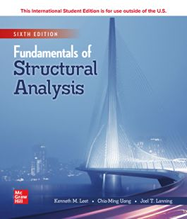Fundamentals of Structural Analysis
Material type: TextLanguage: English Publication details: New York, Ny : McGraw-Hill, c2021Edition: 6th Int. StudentDescription: XVI, 779 p. : illISBN:
TextLanguage: English Publication details: New York, Ny : McGraw-Hill, c2021Edition: 6th Int. StudentDescription: XVI, 779 p. : illISBN: - 9781260570441
- 624.171 LEE
| Item type | Current library | Collection | Shelving location | Call number | Copy number | Status | Date due | Barcode |
|---|---|---|---|---|---|---|---|---|
 Lending Collection
Lending Collection
|
Circulation Section | Department of Civil Engineering | Circulation Section | 624.171 LEE | 2021-2022 | Available | 97691 | |
 Reference Collection
Reference Collection
|
TIEST (Thar) Library | Civil Engineering - Thar Institute | 624.171 LEE | 2022-23 | Available | 98291 |
SUMMARY:
Fundamentals of Structural Analysis introduces to engineering and architecture students a range of techniques for analyzing structures, from classical methods to matrix analysis upon which modern computer analysis is based. After an introduction to design loads, a thoughtful review of prerequisite skills in statics for analyzing statically determinate structures is presented. Methods for computing deflections then pave the way for classical methods of analyzing indeterminate structures–the flexibility, slope-deflection, and moment distribution methods. Approximate analysis techniques useful for practical design are then presented. For application to bridge-type structures with moving loads, the concept of influence lines is also covered. Finally, the stiffness method is introduced and extended upon in the direct stiffness method using matrix analysis. Throughout, carefully drawn figures, helpful insights, and practical examples and problems are presented to make this text a useful guide for students (and practitioners) to learn the essential skills for analyzing structures.
